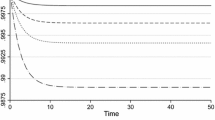Abstract
Utilizing a sample of 51 countries for which price level data for 1980 were available from stage IV of the ICP project, the paper examines the possible role of taxes in explaining the departure of national price levels from purchasing power parities. The results obtained in the paper suggest that the overall burden of central government taxation, especially of indirect domestic taxes, raises the general price level. No such price effects seem to be associated with the direct tax burden, supporting the conventional view of their not being shifted forward. The perhaps unexpected result, that import duties have no discernible effects on the price level, is consistent with earlier findings. Another unexpected result is that the burden of domestic indirect taxation expresses itself in the prices of tradables, rather than of non-tradables. Furthermore, no evidence was found to support the view, that tax inflated prices are offset by reduced prices in the untaxed sector, as required for the price level to be neutral with respect to taxation.
Similar content being viewed by others
References
Balassa, B. (1964). "The Purchasing Power Parity Doctrine: A Reappraisal." Jour. Pol. Ec. 72, 584–596.
Bhagwati, J. N. (1984). "Why are Services Cheaper in the Poorer Countries?" Ec. Jour. 94, 279–286.
Bergstrand, J. H. (1991). "Structural Determinants of Real Exchange Rates and National Price Levels: Some Empirical Evidence." Am. Ec. Rev. 81(1), 325–334.
Clague, C. (1986). "Determinants of the National Price Level: Some Empirical Results." Rev. of Econ. & Stat. 68(2), 320–323, May.
Clague, C. (1988). "Explanations of National Price Levels." In J. Salazar-Carrillo, and D. S. Prasada Rao (eds.), World Comparison of Incomes, Prices and Product. (pp. 237–262).
Clague, C. (1993). "Why are Prices so Low in America?" The World Economy16(5), 600–610.
Clague, C., and V. Tanzi. (1972). "Human Capital, Natural Resources and the Purchasing Power Parity Doctrine: Some Empirical Results." Economia Internazionale25, 3–18.
Falvey, R. E., and N. Gemmell. (1991). "Explaining Service-Price Differences in International Comparisons." Am. Ec. Rev. 81(5), 1295–1309.
Kleiman, E. (1993). "Taxes and the Price Level: A Further Examination of the PPP Hypothesis." IMF Working Paper WP/93/5, Fiscal Affairs Department, International Monetary Fund, February.
Kravis, I., A. Heston and R. Summers. (1978). "Real GDP Per Capita for More than One Hundred Countries." Ec. Jour. 88, 215–242.
Kravis, I., and R. Lipsey. (1983). "Towards an Explanation of National Price Levels." Princeton Studies in International Finance52.
Kravis, I., and R. Lipsey. (1988). "National Price Levels and the Prices of Tradables and Nontradables." NBER Working Paper No. 2536.
Lipsey, R. E., and B. Svendenborg. (1996). "The High Cost of Eating: Causes of International Differences in Consumer Prices." Rev. Income and Wealth42(2), 181–194.
Musgrave, R. A. (1959). The Theory of Public Finance. New York: McGraw Hill.
Panagaryia, A. (1988). "A Theoretical Explanation of Some Stylized Facts of Economic Growth." Quar. Jour. Econ. 103(3), 509–526.
Rogoff, K. (1996). "The Purchasing Power Parity Puzzle." Jour. Econ. Lit. 34, 647–668.
Salazar-Carillo, J. (1990). "Indirect Taxation, Tariff Protection and Price Relatives in the Central American Common Market." In J. Salazar-Carillo, and D. S. Prasada Rao (eds.), Comparisons of Prices and Real Products in Latin America. (pp. 99–107).
Summers, R., and A. Heston. (1984). "Improved International Comparisons of Real Product and Its Composition: 1950–1980." Review of Income and Wealth30(2), 207–262.
Summers, R., and A. Heston. (1988). "A New Set of International Comparisons of Real Product and Its Composition: 1950–1980." Review of Income and Wealth34(1), 1–26.
Tanzi, V. (1983). "Taxation and Price Stabilization." In S. Cnossen (ed.), Comparative Tax Studies: Essays in Honor of Richard Goode. (409–430).
Union Bank of Switzerland. (1988). "Prices and Earnings Around the Globe: A Comparison of Purchasing Power in 52 Cities." UBS Publications on Business, Banking and Monetary Topics, vol. 108.
United Nations, Statistical Office, and Commission of the European Communities. (1986). World Comparison of Purchasing Power and Real Product for 1980: Phase IV of the International Comparison Project. U.N., New York. Part One: Summary Results for 60 Countries. Part Two: Detailed Results for 60 Countries.
Vaillancourt, F. (1987). "The Compliance Cost of Taxes on Business and Individuals: A Review of the Evidence." Public Finance42, 395–414.
Author information
Authors and Affiliations
Rights and permissions
About this article
Cite this article
Kleiman, E. National Price Levels: Do Taxes Matter?. International Tax and Public Finance 4, 361–377 (1997). https://doi.org/10.1023/A:1008672506502
Published:
Issue Date:
DOI: https://doi.org/10.1023/A:1008672506502




